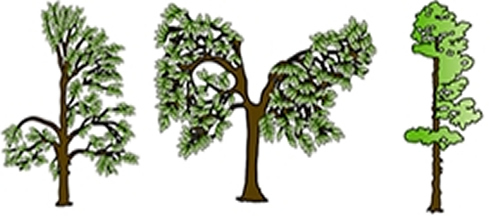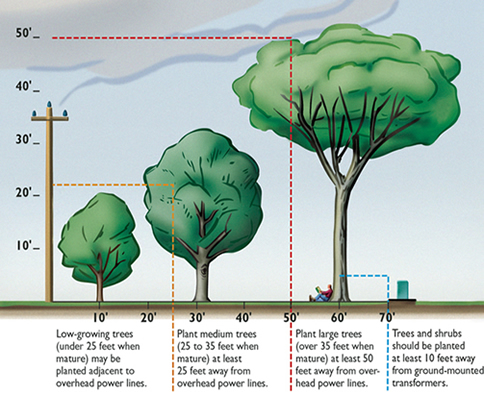Pruning and Tree Trimming
Tree Trimming
Trees that grow too close to power lines can cause outages, start fires or create other hazardous conditions. Generally, we remove trees that pose a serious threat to safety and electric service. Not only does this work help maintain electric safety and service reliability, it is mandated by state and federal regulations (NESC Rules 012, 013, and 218; IEEE Standard 516-2003, Section 4.2.2.3; ANSI Z133.1; OSHA 1910; and WAC 296-45).
Because our tree maintenance activities can have a profound effect on the appearance of trees, the value customers place on high-quality electric service will sometimes conflict with the value they place on trees in their community.
How do we prune?
We hire certified tree-trimmers as well as our own crew of certified tree-trimmers, to maintain a safe corridor around power lines. They use natural pruning methods to maintain the health of the trees. Natural pruning, besides being healthier for the tree, also reduces re-sprouting in problem areas and limits the length of sprouts that do occur. The tree’s species, structure, and the strength of the wood are all considered when trees are pruned.
Neither our contractor nor our in-house crew use “round over” pruning because this method wounds the tree and causes it to grow unnaturally.
In addition to pruning, trees not intentionally planted as part of the landscape (“natural re-prod”) that measure less than six inches in diameter at 4.5 feet high will be removed.
If you’d like a tree pruned or removed for landscaping purposes, you’ll need to hire a private arborist or tree removal contractor to perform the work. If necessary, we can disconnect a service line for their workers’ safety.
How much do we prune?
Pruning clearances depend on tree species and growth patterns, as well as the voltage of power lines in close proximity. Around distribution lines, we provide at least 10 feet of clearance. Fast-growing species common to Clallam and Jefferson Counties (ie, willow, alder, maple, and cottonwood) require 14 feet of clearance while slow-growing species (spruce, fir, and cedar) require at least 10 feet of clearance.
Tree Removal
Sometimes the best solution to tree and power line conflicts is tree removal. We work with neighborhoods to remove problem trees, particularly in cases where they require repeated pruning. Tree removal is especially important where pruning alone cannot achieve safe clearance from power lines.
Along stretches of road where there are no houses, we remove problem trees from the public right-of-way. It saves our customers money to remove them rather than trim repeatedly. We would never remove yard trees without first talking with the homeowner, though we might trim them if we’re unable to reach the homeowner beforehand. We work with the wishes of our customers whenever we are able to without endangering our personnel or the reliability of the system.
We also utilize a brushing machine in our vegetation management cycles to keep access roads open, to remove brush as needed along our rights-of-way, and to remove recurring tree growth under or adjacent to our power lines.
What can you do to help?
While Clallam County PUD maintains a rigorous tree-maintenance program for trees along power line rights-of-way, approximately 90 percent of tree-related outages are caused by trees growing outside of the right-of-way – for example, a tree growing in a front yard rather than a parking strip.
What happens if I refuse Clallam County PUD, or its tree pruning crews, access to my tree?
Clallam County PUD is obligated to keep lines clear to provide power to the community and our customers. We can, as an absolute last resort, pursue legal means.
Why don’t you relocate your overhead lines to underground?
The cost to install underground lines is $5000 to $10,000 per homeowner, minimum.
Underground cable life is typically less than 20 years. Any time a cable fails, Clallam County PUD would have to dig down and repair the faulted line. In addition, relocating overhead lines to underground cable often destroys a tree’s root system.
Can the time of year for line clearing be changed?
No. The tree service works in cycles. It is inefficient and costly to move out of the cycles. With proper pruning, time of year will not affect the health of the tree.
How often are you going to prune my tree?
About every three to five years.
Why are you asking my permission to prune?
Technically, we are performing a notification of work to be performed. We do this as a courtesy to you, our customer. We have rights to the property, which provides us access to maintain our power lines












